Education Report: International NGOs, Civil Society and Development
VerifiedAdded on 2023/06/09
|15
|3799
|180
Report
AI Summary
This report provides an in-depth analysis of Non-Governmental Development Organizations (NGDOs), commonly known as NGOs, and their crucial role in international development, particularly in addressing issues like poverty, illiteracy, and poor health. It explores the nature, roles, and responsibilities of NGOs, highlighting their significance in providing essential social services, undertaking community development, and protecting the environment. The report discusses the challenges faced by NGOs, including organizational structure, funding, and relationships with governments, using examples such as The African Programme for Onchocerciasis Control (APOC) and the work of Sightsavers in combating river blindness. It emphasizes the importance of collaboration, participatory development, and good governance in creating a conducive environment for NGOs to overcome these challenges and achieve their goals. The report also examines how NGOs can navigate complex political landscapes, improve their effectiveness, and enhance their impact on communities.
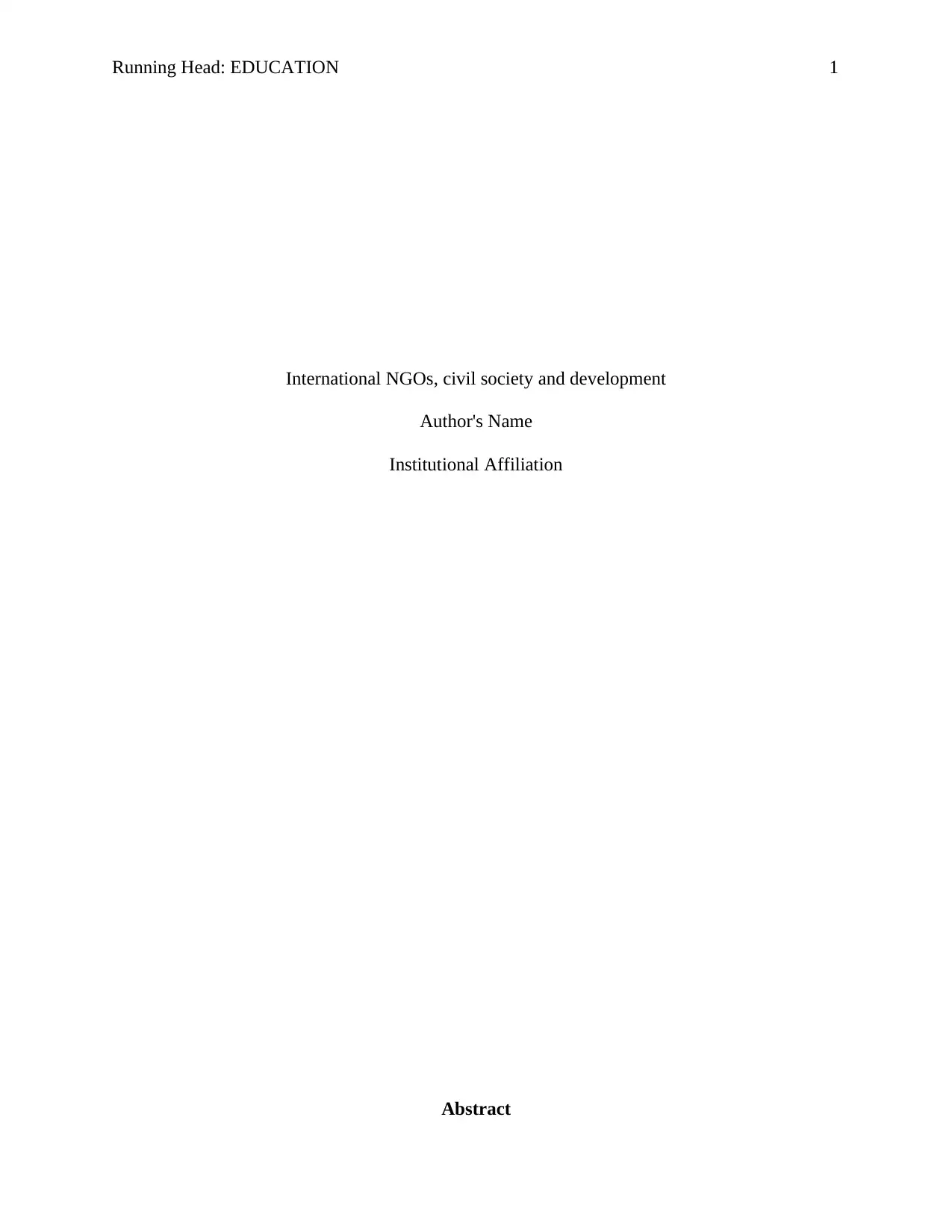
Running Head: EDUCATION 1
International NGOs, civil society and development
Author's Name
Institutional Affiliation
Abstract
International NGOs, civil society and development
Author's Name
Institutional Affiliation
Abstract
Paraphrase This Document
Need a fresh take? Get an instant paraphrase of this document with our AI Paraphraser
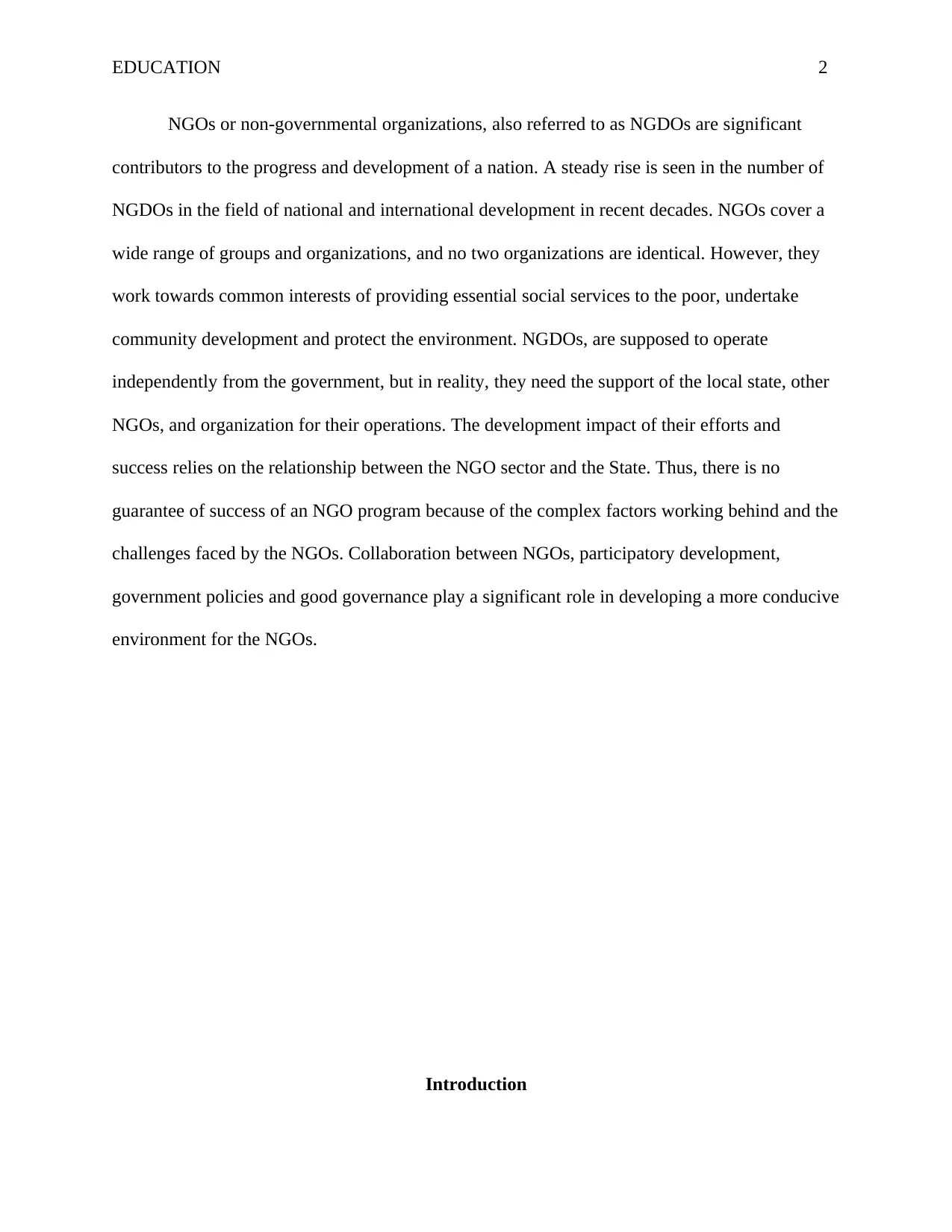
EDUCATION 2
NGOs or non-governmental organizations, also referred to as NGDOs are significant
contributors to the progress and development of a nation. A steady rise is seen in the number of
NGDOs in the field of national and international development in recent decades. NGOs cover a
wide range of groups and organizations, and no two organizations are identical. However, they
work towards common interests of providing essential social services to the poor, undertake
community development and protect the environment. NGDOs, are supposed to operate
independently from the government, but in reality, they need the support of the local state, other
NGOs, and organization for their operations. The development impact of their efforts and
success relies on the relationship between the NGO sector and the State. Thus, there is no
guarantee of success of an NGO program because of the complex factors working behind and the
challenges faced by the NGOs. Collaboration between NGOs, participatory development,
government policies and good governance play a significant role in developing a more conducive
environment for the NGOs.
Introduction
NGOs or non-governmental organizations, also referred to as NGDOs are significant
contributors to the progress and development of a nation. A steady rise is seen in the number of
NGDOs in the field of national and international development in recent decades. NGOs cover a
wide range of groups and organizations, and no two organizations are identical. However, they
work towards common interests of providing essential social services to the poor, undertake
community development and protect the environment. NGDOs, are supposed to operate
independently from the government, but in reality, they need the support of the local state, other
NGOs, and organization for their operations. The development impact of their efforts and
success relies on the relationship between the NGO sector and the State. Thus, there is no
guarantee of success of an NGO program because of the complex factors working behind and the
challenges faced by the NGOs. Collaboration between NGOs, participatory development,
government policies and good governance play a significant role in developing a more conducive
environment for the NGOs.
Introduction
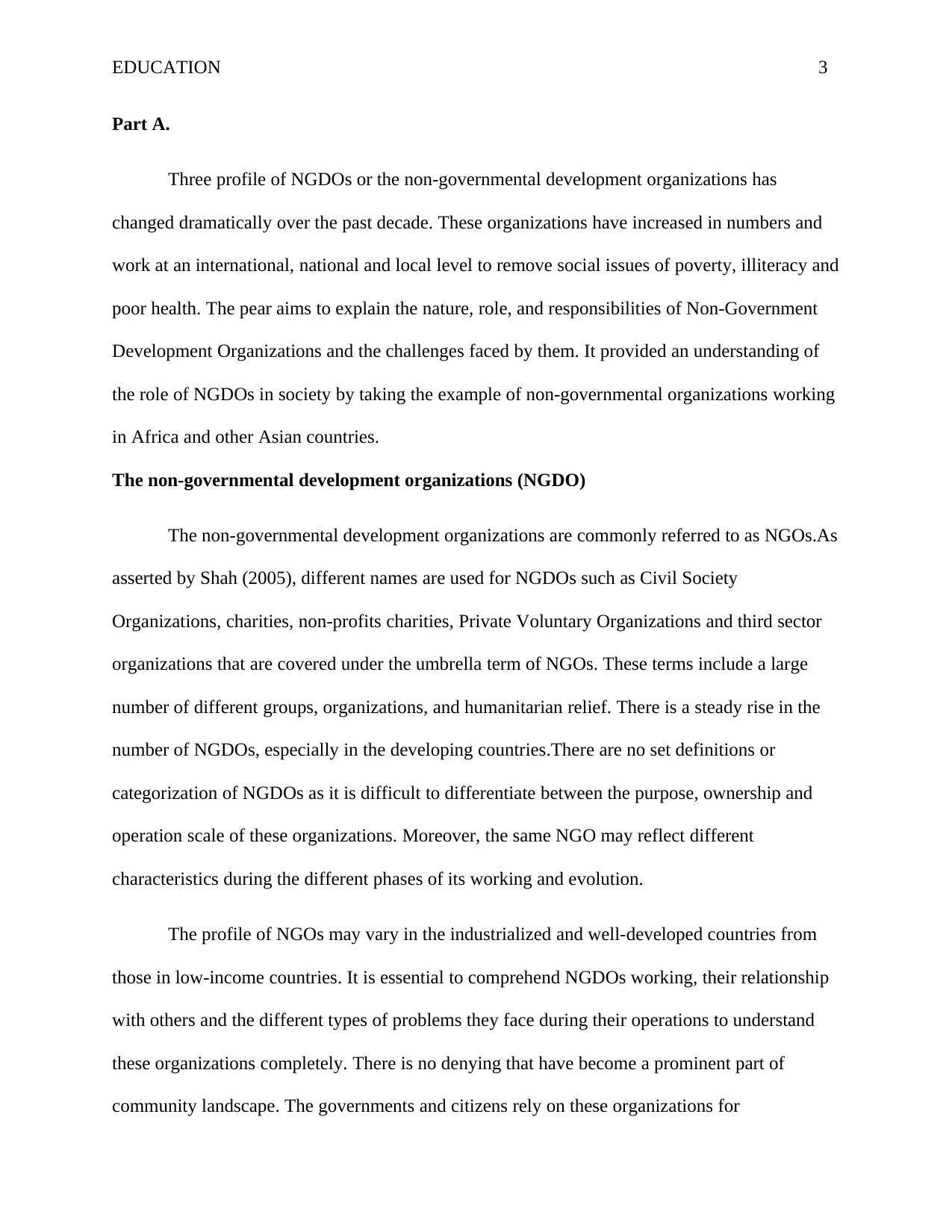
EDUCATION 3
Part A.
Three profile of NGDOs or the non-governmental development organizations has
changed dramatically over the past decade. These organizations have increased in numbers and
work at an international, national and local level to remove social issues of poverty, illiteracy and
poor health. The pear aims to explain the nature, role, and responsibilities of Non-Government
Development Organizations and the challenges faced by them. It provided an understanding of
the role of NGDOs in society by taking the example of non-governmental organizations working
in Africa and other Asian countries.
The non-governmental development organizations (NGDO)
The non-governmental development organizations are commonly referred to as NGOs.As
asserted by Shah (2005), different names are used for NGDOs such as Civil Society
Organizations, charities, non-profits charities, Private Voluntary Organizations and third sector
organizations that are covered under the umbrella term of NGOs. These terms include a large
number of different groups, organizations, and humanitarian relief. There is a steady rise in the
number of NGDOs, especially in the developing countries.There are no set definitions or
categorization of NGDOs as it is difficult to differentiate between the purpose, ownership and
operation scale of these organizations. Moreover, the same NGO may reflect different
characteristics during the different phases of its working and evolution.
The profile of NGOs may vary in the industrialized and well-developed countries from
those in low-income countries. It is essential to comprehend NGDOs working, their relationship
with others and the different types of problems they face during their operations to understand
these organizations completely. There is no denying that have become a prominent part of
community landscape. The governments and citizens rely on these organizations for
Part A.
Three profile of NGDOs or the non-governmental development organizations has
changed dramatically over the past decade. These organizations have increased in numbers and
work at an international, national and local level to remove social issues of poverty, illiteracy and
poor health. The pear aims to explain the nature, role, and responsibilities of Non-Government
Development Organizations and the challenges faced by them. It provided an understanding of
the role of NGDOs in society by taking the example of non-governmental organizations working
in Africa and other Asian countries.
The non-governmental development organizations (NGDO)
The non-governmental development organizations are commonly referred to as NGOs.As
asserted by Shah (2005), different names are used for NGDOs such as Civil Society
Organizations, charities, non-profits charities, Private Voluntary Organizations and third sector
organizations that are covered under the umbrella term of NGOs. These terms include a large
number of different groups, organizations, and humanitarian relief. There is a steady rise in the
number of NGDOs, especially in the developing countries.There are no set definitions or
categorization of NGDOs as it is difficult to differentiate between the purpose, ownership and
operation scale of these organizations. Moreover, the same NGO may reflect different
characteristics during the different phases of its working and evolution.
The profile of NGOs may vary in the industrialized and well-developed countries from
those in low-income countries. It is essential to comprehend NGDOs working, their relationship
with others and the different types of problems they face during their operations to understand
these organizations completely. There is no denying that have become a prominent part of
community landscape. The governments and citizens rely on these organizations for
⊘ This is a preview!⊘
Do you want full access?
Subscribe today to unlock all pages.

Trusted by 1+ million students worldwide
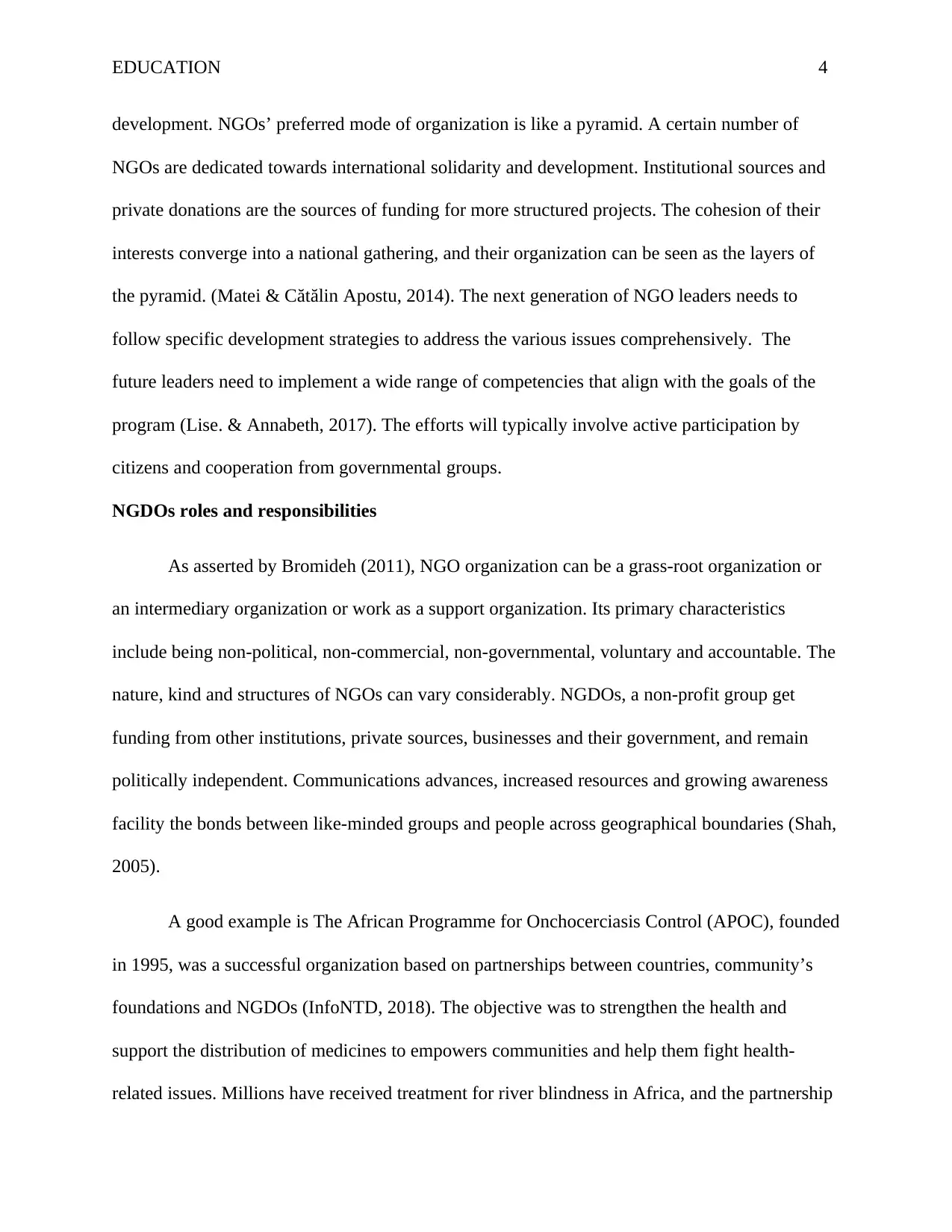
EDUCATION 4
development. NGOs’ preferred mode of organization is like a pyramid. A certain number of
NGOs are dedicated towards international solidarity and development. Institutional sources and
private donations are the sources of funding for more structured projects. The cohesion of their
interests converge into a national gathering, and their organization can be seen as the layers of
the pyramid. (Matei & Cătălin Apostu, 2014). The next generation of NGO leaders needs to
follow specific development strategies to address the various issues comprehensively. The
future leaders need to implement a wide range of competencies that align with the goals of the
program (Lise. & Annabeth, 2017). The efforts will typically involve active participation by
citizens and cooperation from governmental groups.
NGDOs roles and responsibilities
As asserted by Bromideh (2011), NGO organization can be a grass-root organization or
an intermediary organization or work as a support organization. Its primary characteristics
include being non-political, non-commercial, non-governmental, voluntary and accountable. The
nature, kind and structures of NGOs can vary considerably. NGDOs, a non-profit group get
funding from other institutions, private sources, businesses and their government, and remain
politically independent. Communications advances, increased resources and growing awareness
facility the bonds between like-minded groups and people across geographical boundaries (Shah,
2005).
A good example is The African Programme for Onchocerciasis Control (APOC), founded
in 1995, was a successful organization based on partnerships between countries, community’s
foundations and NGDOs (InfoNTD, 2018). The objective was to strengthen the health and
support the distribution of medicines to empowers communities and help them fight health-
related issues. Millions have received treatment for river blindness in Africa, and the partnership
development. NGOs’ preferred mode of organization is like a pyramid. A certain number of
NGOs are dedicated towards international solidarity and development. Institutional sources and
private donations are the sources of funding for more structured projects. The cohesion of their
interests converge into a national gathering, and their organization can be seen as the layers of
the pyramid. (Matei & Cătălin Apostu, 2014). The next generation of NGO leaders needs to
follow specific development strategies to address the various issues comprehensively. The
future leaders need to implement a wide range of competencies that align with the goals of the
program (Lise. & Annabeth, 2017). The efforts will typically involve active participation by
citizens and cooperation from governmental groups.
NGDOs roles and responsibilities
As asserted by Bromideh (2011), NGO organization can be a grass-root organization or
an intermediary organization or work as a support organization. Its primary characteristics
include being non-political, non-commercial, non-governmental, voluntary and accountable. The
nature, kind and structures of NGOs can vary considerably. NGDOs, a non-profit group get
funding from other institutions, private sources, businesses and their government, and remain
politically independent. Communications advances, increased resources and growing awareness
facility the bonds between like-minded groups and people across geographical boundaries (Shah,
2005).
A good example is The African Programme for Onchocerciasis Control (APOC), founded
in 1995, was a successful organization based on partnerships between countries, community’s
foundations and NGDOs (InfoNTD, 2018). The objective was to strengthen the health and
support the distribution of medicines to empowers communities and help them fight health-
related issues. Millions have received treatment for river blindness in Africa, and the partnership
Paraphrase This Document
Need a fresh take? Get an instant paraphrase of this document with our AI Paraphraser
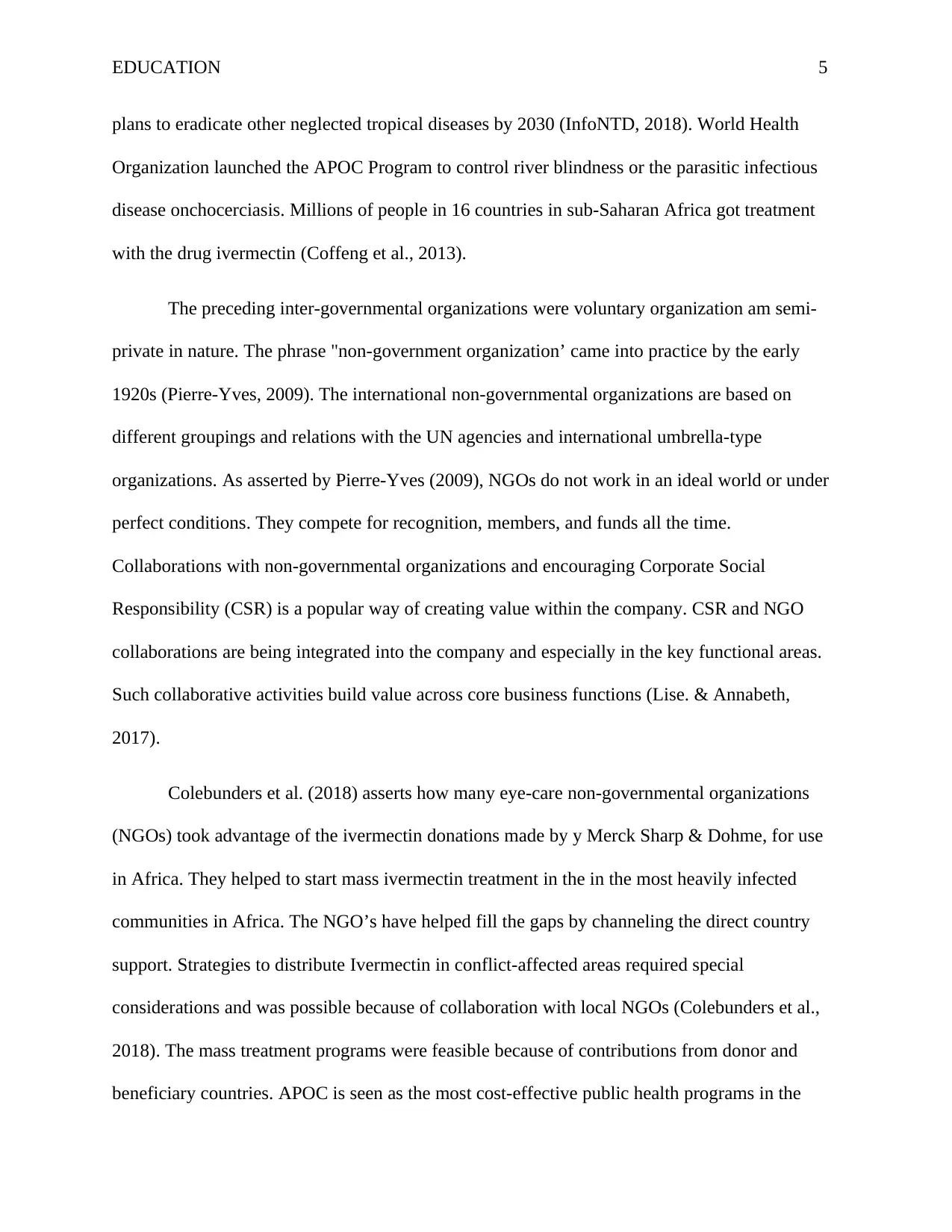
EDUCATION 5
plans to eradicate other neglected tropical diseases by 2030 (InfoNTD, 2018). World Health
Organization launched the APOC Program to control river blindness or the parasitic infectious
disease onchocerciasis. Millions of people in 16 countries in sub-Saharan Africa got treatment
with the drug ivermectin (Coffeng et al., 2013).
The preceding inter-governmental organizations were voluntary organization am semi-
private in nature. The phrase "non-government organization’ came into practice by the early
1920s (Pierre-Yves, 2009). The international non-governmental organizations are based on
different groupings and relations with the UN agencies and international umbrella-type
organizations. As asserted by Pierre-Yves (2009), NGOs do not work in an ideal world or under
perfect conditions. They compete for recognition, members, and funds all the time.
Collaborations with non-governmental organizations and encouraging Corporate Social
Responsibility (CSR) is a popular way of creating value within the company. CSR and NGO
collaborations are being integrated into the company and especially in the key functional areas.
Such collaborative activities build value across core business functions (Lise. & Annabeth,
2017).
Colebunders et al. (2018) asserts how many eye-care non-governmental organizations
(NGOs) took advantage of the ivermectin donations made by y Merck Sharp & Dohme, for use
in Africa. They helped to start mass ivermectin treatment in the in the most heavily infected
communities in Africa. The NGO’s have helped fill the gaps by channeling the direct country
support. Strategies to distribute Ivermectin in conflict-affected areas required special
considerations and was possible because of collaboration with local NGOs (Colebunders et al.,
2018). The mass treatment programs were feasible because of contributions from donor and
beneficiary countries. APOC is seen as the most cost-effective public health programs in the
plans to eradicate other neglected tropical diseases by 2030 (InfoNTD, 2018). World Health
Organization launched the APOC Program to control river blindness or the parasitic infectious
disease onchocerciasis. Millions of people in 16 countries in sub-Saharan Africa got treatment
with the drug ivermectin (Coffeng et al., 2013).
The preceding inter-governmental organizations were voluntary organization am semi-
private in nature. The phrase "non-government organization’ came into practice by the early
1920s (Pierre-Yves, 2009). The international non-governmental organizations are based on
different groupings and relations with the UN agencies and international umbrella-type
organizations. As asserted by Pierre-Yves (2009), NGOs do not work in an ideal world or under
perfect conditions. They compete for recognition, members, and funds all the time.
Collaborations with non-governmental organizations and encouraging Corporate Social
Responsibility (CSR) is a popular way of creating value within the company. CSR and NGO
collaborations are being integrated into the company and especially in the key functional areas.
Such collaborative activities build value across core business functions (Lise. & Annabeth,
2017).
Colebunders et al. (2018) asserts how many eye-care non-governmental organizations
(NGOs) took advantage of the ivermectin donations made by y Merck Sharp & Dohme, for use
in Africa. They helped to start mass ivermectin treatment in the in the most heavily infected
communities in Africa. The NGO’s have helped fill the gaps by channeling the direct country
support. Strategies to distribute Ivermectin in conflict-affected areas required special
considerations and was possible because of collaboration with local NGOs (Colebunders et al.,
2018). The mass treatment programs were feasible because of contributions from donor and
beneficiary countries. APOC is seen as the most cost-effective public health programs in the
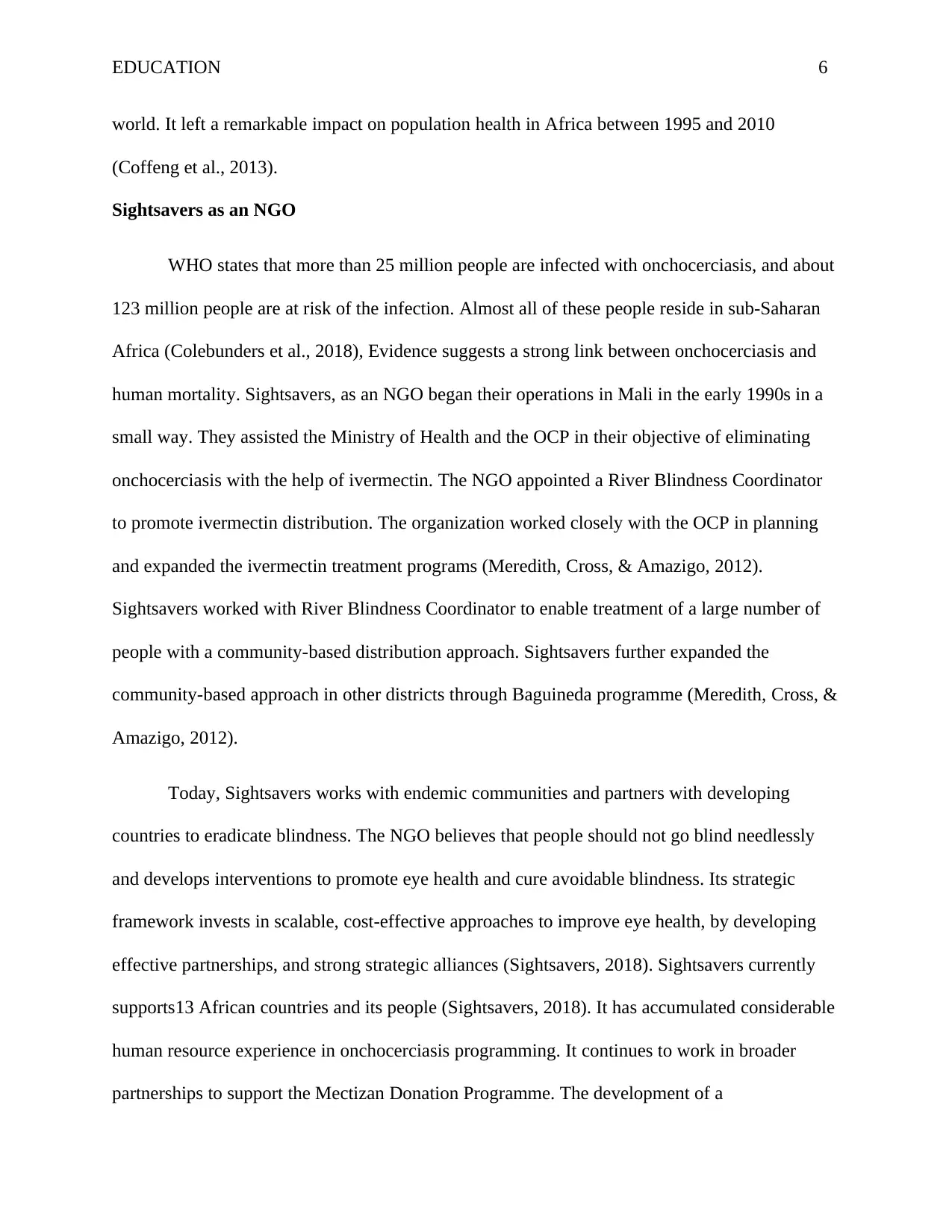
EDUCATION 6
world. It left a remarkable impact on population health in Africa between 1995 and 2010
(Coffeng et al., 2013).
Sightsavers as an NGO
WHO states that more than 25 million people are infected with onchocerciasis, and about
123 million people are at risk of the infection. Almost all of these people reside in sub-Saharan
Africa (Colebunders et al., 2018), Evidence suggests a strong link between onchocerciasis and
human mortality. Sightsavers, as an NGO began their operations in Mali in the early 1990s in a
small way. They assisted the Ministry of Health and the OCP in their objective of eliminating
onchocerciasis with the help of ivermectin. The NGO appointed a River Blindness Coordinator
to promote ivermectin distribution. The organization worked closely with the OCP in planning
and expanded the ivermectin treatment programs (Meredith, Cross, & Amazigo, 2012).
Sightsavers worked with River Blindness Coordinator to enable treatment of a large number of
people with a community-based distribution approach. Sightsavers further expanded the
community-based approach in other districts through Baguineda programme (Meredith, Cross, &
Amazigo, 2012).
Today, Sightsavers works with endemic communities and partners with developing
countries to eradicate blindness. The NGO believes that people should not go blind needlessly
and develops interventions to promote eye health and cure avoidable blindness. Its strategic
framework invests in scalable, cost-effective approaches to improve eye health, by developing
effective partnerships, and strong strategic alliances (Sightsavers, 2018). Sightsavers currently
supports13 African countries and its people (Sightsavers, 2018). It has accumulated considerable
human resource experience in onchocerciasis programming. It continues to work in broader
partnerships to support the Mectizan Donation Programme. The development of a
world. It left a remarkable impact on population health in Africa between 1995 and 2010
(Coffeng et al., 2013).
Sightsavers as an NGO
WHO states that more than 25 million people are infected with onchocerciasis, and about
123 million people are at risk of the infection. Almost all of these people reside in sub-Saharan
Africa (Colebunders et al., 2018), Evidence suggests a strong link between onchocerciasis and
human mortality. Sightsavers, as an NGO began their operations in Mali in the early 1990s in a
small way. They assisted the Ministry of Health and the OCP in their objective of eliminating
onchocerciasis with the help of ivermectin. The NGO appointed a River Blindness Coordinator
to promote ivermectin distribution. The organization worked closely with the OCP in planning
and expanded the ivermectin treatment programs (Meredith, Cross, & Amazigo, 2012).
Sightsavers worked with River Blindness Coordinator to enable treatment of a large number of
people with a community-based distribution approach. Sightsavers further expanded the
community-based approach in other districts through Baguineda programme (Meredith, Cross, &
Amazigo, 2012).
Today, Sightsavers works with endemic communities and partners with developing
countries to eradicate blindness. The NGO believes that people should not go blind needlessly
and develops interventions to promote eye health and cure avoidable blindness. Its strategic
framework invests in scalable, cost-effective approaches to improve eye health, by developing
effective partnerships, and strong strategic alliances (Sightsavers, 2018). Sightsavers currently
supports13 African countries and its people (Sightsavers, 2018). It has accumulated considerable
human resource experience in onchocerciasis programming. It continues to work in broader
partnerships to support the Mectizan Donation Programme. The development of a
⊘ This is a preview!⊘
Do you want full access?
Subscribe today to unlock all pages.

Trusted by 1+ million students worldwide
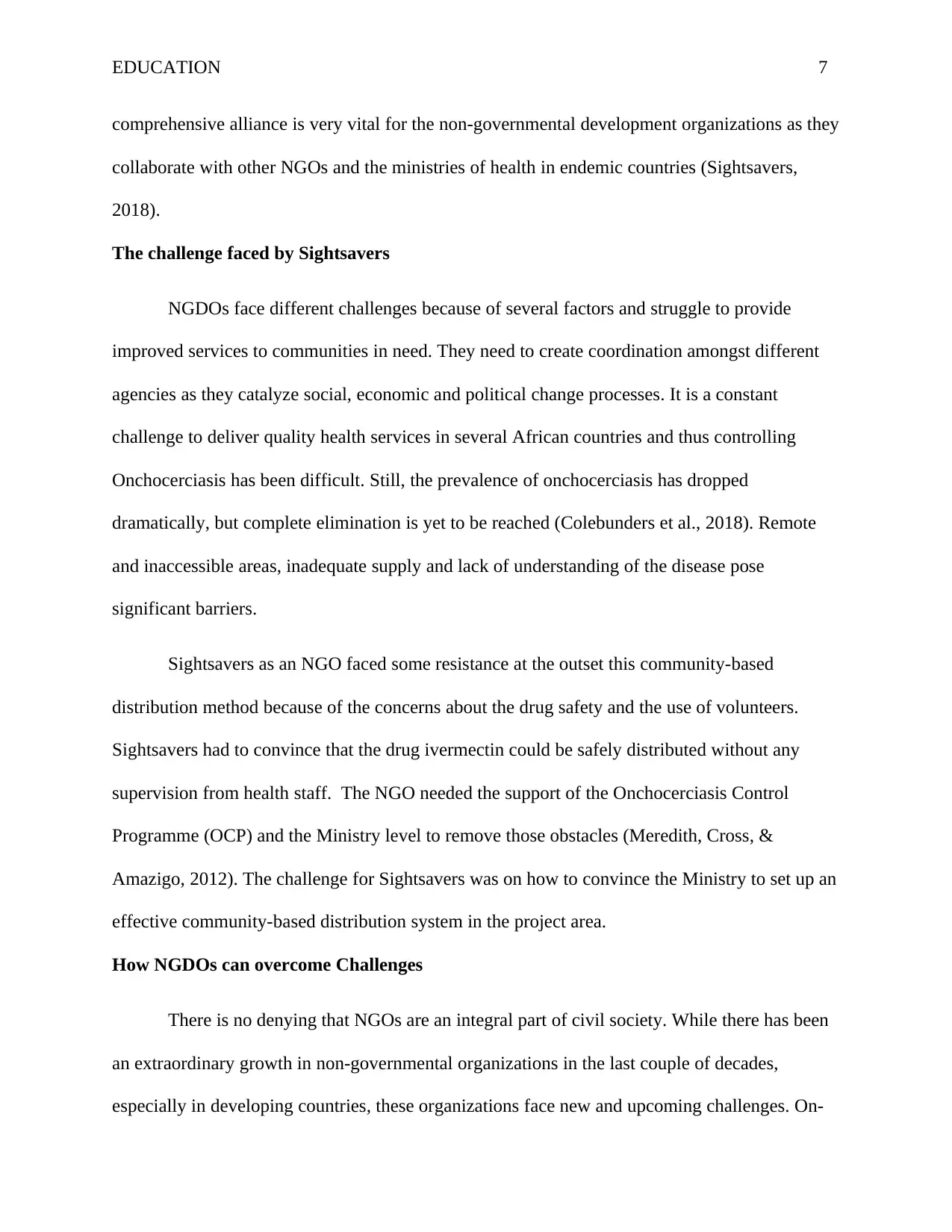
EDUCATION 7
comprehensive alliance is very vital for the non-governmental development organizations as they
collaborate with other NGOs and the ministries of health in endemic countries (Sightsavers,
2018).
The challenge faced by Sightsavers
NGDOs face different challenges because of several factors and struggle to provide
improved services to communities in need. They need to create coordination amongst different
agencies as they catalyze social, economic and political change processes. It is a constant
challenge to deliver quality health services in several African countries and thus controlling
Onchocerciasis has been difficult. Still, the prevalence of onchocerciasis has dropped
dramatically, but complete elimination is yet to be reached (Colebunders et al., 2018). Remote
and inaccessible areas, inadequate supply and lack of understanding of the disease pose
significant barriers.
Sightsavers as an NGO faced some resistance at the outset this community-based
distribution method because of the concerns about the drug safety and the use of volunteers.
Sightsavers had to convince that the drug ivermectin could be safely distributed without any
supervision from health staff. The NGO needed the support of the Onchocerciasis Control
Programme (OCP) and the Ministry level to remove those obstacles (Meredith, Cross, &
Amazigo, 2012). The challenge for Sightsavers was on how to convince the Ministry to set up an
effective community-based distribution system in the project area.
How NGDOs can overcome Challenges
There is no denying that NGOs are an integral part of civil society. While there has been
an extraordinary growth in non-governmental organizations in the last couple of decades,
especially in developing countries, these organizations face new and upcoming challenges. On-
comprehensive alliance is very vital for the non-governmental development organizations as they
collaborate with other NGOs and the ministries of health in endemic countries (Sightsavers,
2018).
The challenge faced by Sightsavers
NGDOs face different challenges because of several factors and struggle to provide
improved services to communities in need. They need to create coordination amongst different
agencies as they catalyze social, economic and political change processes. It is a constant
challenge to deliver quality health services in several African countries and thus controlling
Onchocerciasis has been difficult. Still, the prevalence of onchocerciasis has dropped
dramatically, but complete elimination is yet to be reached (Colebunders et al., 2018). Remote
and inaccessible areas, inadequate supply and lack of understanding of the disease pose
significant barriers.
Sightsavers as an NGO faced some resistance at the outset this community-based
distribution method because of the concerns about the drug safety and the use of volunteers.
Sightsavers had to convince that the drug ivermectin could be safely distributed without any
supervision from health staff. The NGO needed the support of the Onchocerciasis Control
Programme (OCP) and the Ministry level to remove those obstacles (Meredith, Cross, &
Amazigo, 2012). The challenge for Sightsavers was on how to convince the Ministry to set up an
effective community-based distribution system in the project area.
How NGDOs can overcome Challenges
There is no denying that NGOs are an integral part of civil society. While there has been
an extraordinary growth in non-governmental organizations in the last couple of decades,
especially in developing countries, these organizations face new and upcoming challenges. On-
Paraphrase This Document
Need a fresh take? Get an instant paraphrase of this document with our AI Paraphraser
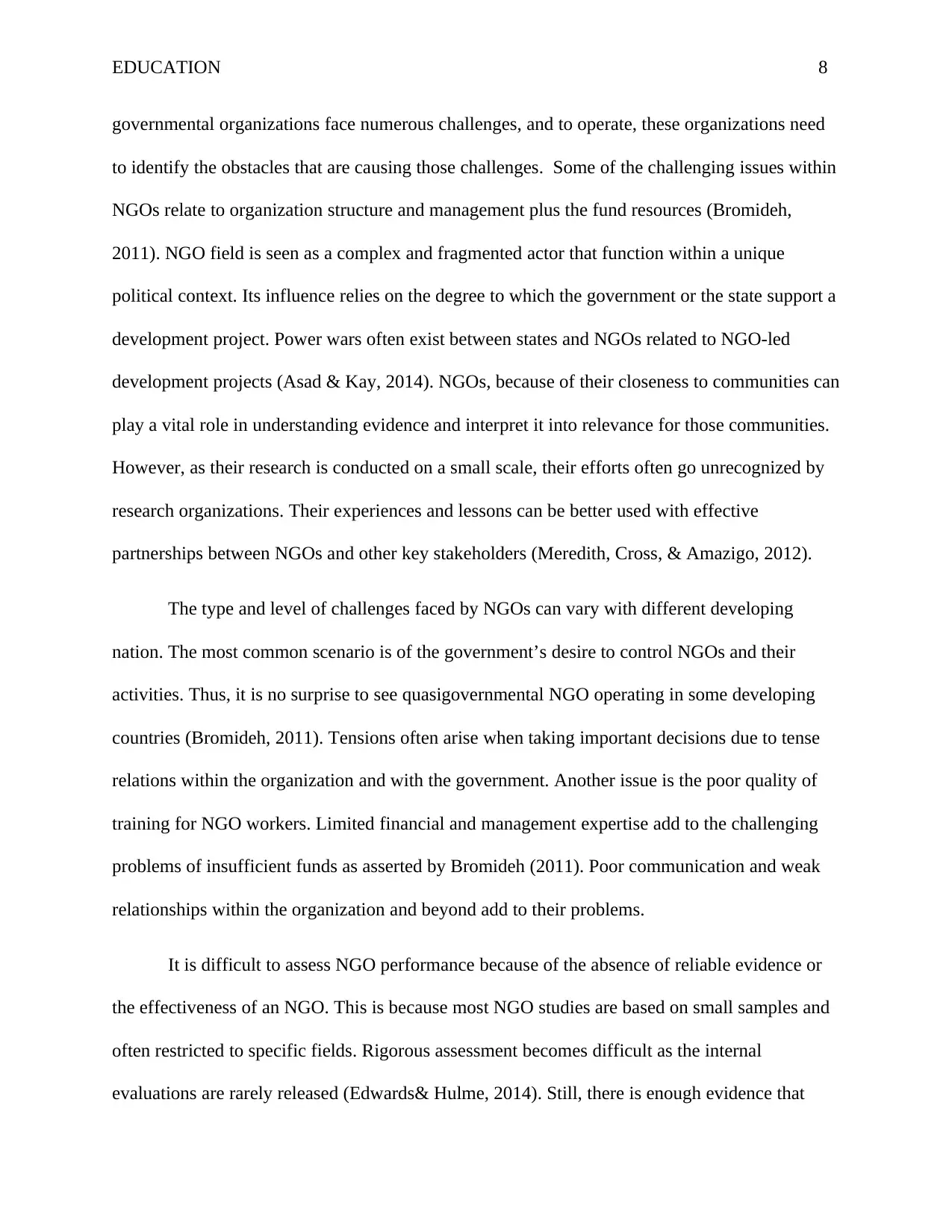
EDUCATION 8
governmental organizations face numerous challenges, and to operate, these organizations need
to identify the obstacles that are causing those challenges. Some of the challenging issues within
NGOs relate to organization structure and management plus the fund resources (Bromideh,
2011). NGO field is seen as a complex and fragmented actor that function within a unique
political context. Its influence relies on the degree to which the government or the state support a
development project. Power wars often exist between states and NGOs related to NGO-led
development projects (Asad & Kay, 2014). NGOs, because of their closeness to communities can
play a vital role in understanding evidence and interpret it into relevance for those communities.
However, as their research is conducted on a small scale, their efforts often go unrecognized by
research organizations. Their experiences and lessons can be better used with effective
partnerships between NGOs and other key stakeholders (Meredith, Cross, & Amazigo, 2012).
The type and level of challenges faced by NGOs can vary with different developing
nation. The most common scenario is of the government’s desire to control NGOs and their
activities. Thus, it is no surprise to see quasigovernmental NGO operating in some developing
countries (Bromideh, 2011). Tensions often arise when taking important decisions due to tense
relations within the organization and with the government. Another issue is the poor quality of
training for NGO workers. Limited financial and management expertise add to the challenging
problems of insufficient funds as asserted by Bromideh (2011). Poor communication and weak
relationships within the organization and beyond add to their problems.
It is difficult to assess NGO performance because of the absence of reliable evidence or
the effectiveness of an NGO. This is because most NGO studies are based on small samples and
often restricted to specific fields. Rigorous assessment becomes difficult as the internal
evaluations are rarely released (Edwards& Hulme, 2014). Still, there is enough evidence that
governmental organizations face numerous challenges, and to operate, these organizations need
to identify the obstacles that are causing those challenges. Some of the challenging issues within
NGOs relate to organization structure and management plus the fund resources (Bromideh,
2011). NGO field is seen as a complex and fragmented actor that function within a unique
political context. Its influence relies on the degree to which the government or the state support a
development project. Power wars often exist between states and NGOs related to NGO-led
development projects (Asad & Kay, 2014). NGOs, because of their closeness to communities can
play a vital role in understanding evidence and interpret it into relevance for those communities.
However, as their research is conducted on a small scale, their efforts often go unrecognized by
research organizations. Their experiences and lessons can be better used with effective
partnerships between NGOs and other key stakeholders (Meredith, Cross, & Amazigo, 2012).
The type and level of challenges faced by NGOs can vary with different developing
nation. The most common scenario is of the government’s desire to control NGOs and their
activities. Thus, it is no surprise to see quasigovernmental NGO operating in some developing
countries (Bromideh, 2011). Tensions often arise when taking important decisions due to tense
relations within the organization and with the government. Another issue is the poor quality of
training for NGO workers. Limited financial and management expertise add to the challenging
problems of insufficient funds as asserted by Bromideh (2011). Poor communication and weak
relationships within the organization and beyond add to their problems.
It is difficult to assess NGO performance because of the absence of reliable evidence or
the effectiveness of an NGO. This is because most NGO studies are based on small samples and
often restricted to specific fields. Rigorous assessment becomes difficult as the internal
evaluations are rarely released (Edwards& Hulme, 2014). Still, there is enough evidence that
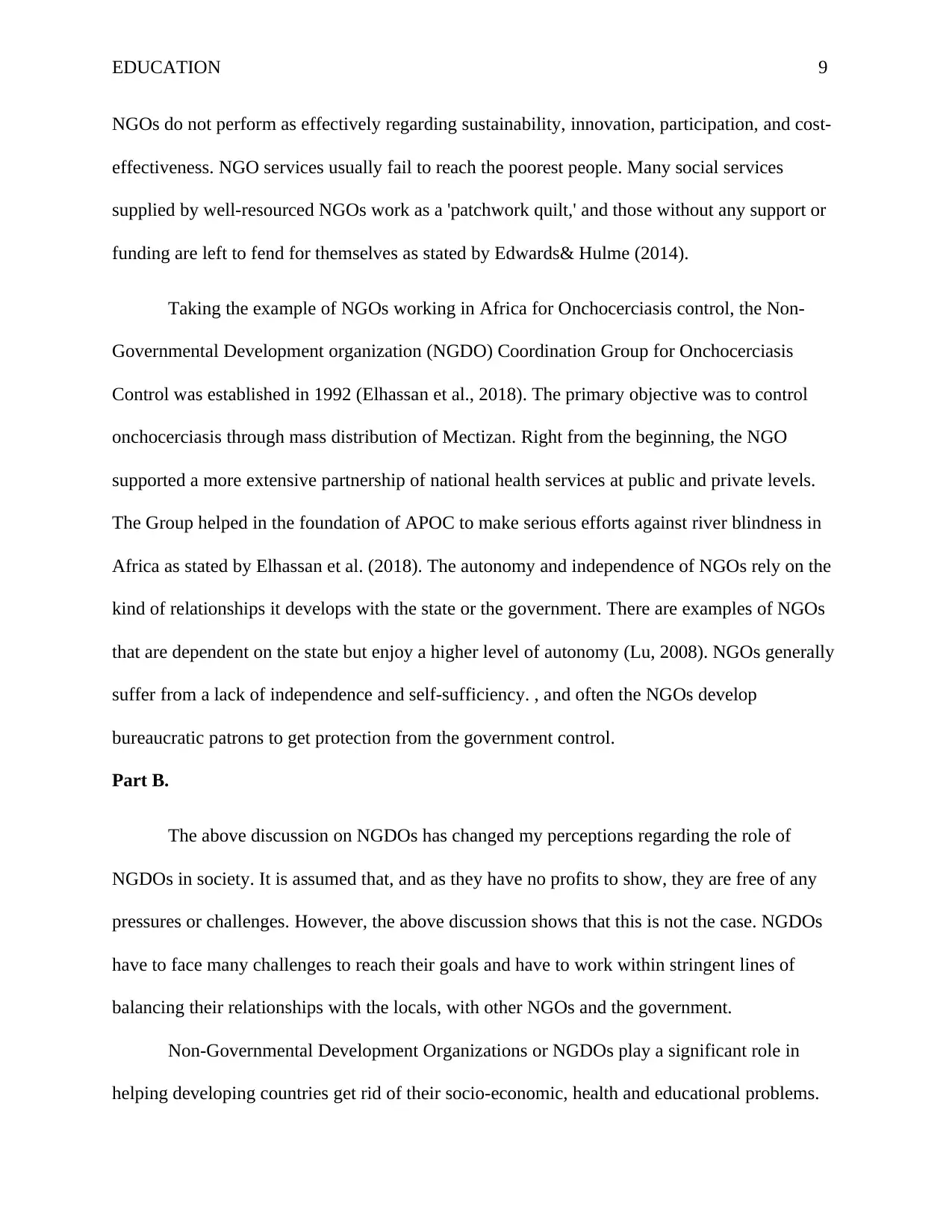
EDUCATION 9
NGOs do not perform as effectively regarding sustainability, innovation, participation, and cost-
effectiveness. NGO services usually fail to reach the poorest people. Many social services
supplied by well-resourced NGOs work as a 'patchwork quilt,' and those without any support or
funding are left to fend for themselves as stated by Edwards& Hulme (2014).
Taking the example of NGOs working in Africa for Onchocerciasis control, the Non-
Governmental Development organization (NGDO) Coordination Group for Onchocerciasis
Control was established in 1992 (Elhassan et al., 2018). The primary objective was to control
onchocerciasis through mass distribution of Mectizan. Right from the beginning, the NGO
supported a more extensive partnership of national health services at public and private levels.
The Group helped in the foundation of APOC to make serious efforts against river blindness in
Africa as stated by Elhassan et al. (2018). The autonomy and independence of NGOs rely on the
kind of relationships it develops with the state or the government. There are examples of NGOs
that are dependent on the state but enjoy a higher level of autonomy (Lu, 2008). NGOs generally
suffer from a lack of independence and self-sufficiency. , and often the NGOs develop
bureaucratic patrons to get protection from the government control.
Part B.
The above discussion on NGDOs has changed my perceptions regarding the role of
NGDOs in society. It is assumed that, and as they have no profits to show, they are free of any
pressures or challenges. However, the above discussion shows that this is not the case. NGDOs
have to face many challenges to reach their goals and have to work within stringent lines of
balancing their relationships with the locals, with other NGOs and the government.
Non-Governmental Development Organizations or NGDOs play a significant role in
helping developing countries get rid of their socio-economic, health and educational problems.
NGOs do not perform as effectively regarding sustainability, innovation, participation, and cost-
effectiveness. NGO services usually fail to reach the poorest people. Many social services
supplied by well-resourced NGOs work as a 'patchwork quilt,' and those without any support or
funding are left to fend for themselves as stated by Edwards& Hulme (2014).
Taking the example of NGOs working in Africa for Onchocerciasis control, the Non-
Governmental Development organization (NGDO) Coordination Group for Onchocerciasis
Control was established in 1992 (Elhassan et al., 2018). The primary objective was to control
onchocerciasis through mass distribution of Mectizan. Right from the beginning, the NGO
supported a more extensive partnership of national health services at public and private levels.
The Group helped in the foundation of APOC to make serious efforts against river blindness in
Africa as stated by Elhassan et al. (2018). The autonomy and independence of NGOs rely on the
kind of relationships it develops with the state or the government. There are examples of NGOs
that are dependent on the state but enjoy a higher level of autonomy (Lu, 2008). NGOs generally
suffer from a lack of independence and self-sufficiency. , and often the NGOs develop
bureaucratic patrons to get protection from the government control.
Part B.
The above discussion on NGDOs has changed my perceptions regarding the role of
NGDOs in society. It is assumed that, and as they have no profits to show, they are free of any
pressures or challenges. However, the above discussion shows that this is not the case. NGDOs
have to face many challenges to reach their goals and have to work within stringent lines of
balancing their relationships with the locals, with other NGOs and the government.
Non-Governmental Development Organizations or NGDOs play a significant role in
helping developing countries get rid of their socio-economic, health and educational problems.
⊘ This is a preview!⊘
Do you want full access?
Subscribe today to unlock all pages.

Trusted by 1+ million students worldwide
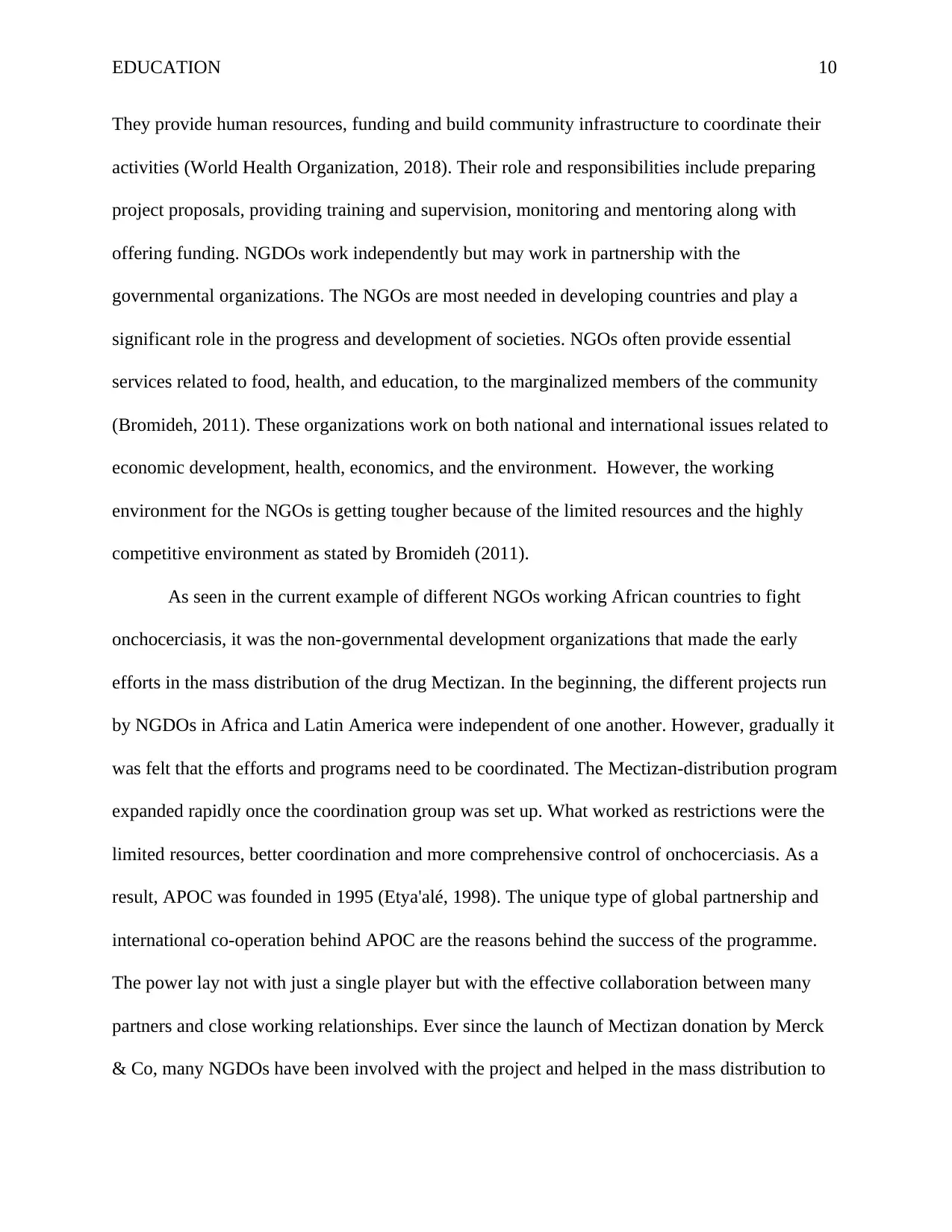
EDUCATION 10
They provide human resources, funding and build community infrastructure to coordinate their
activities (World Health Organization, 2018). Their role and responsibilities include preparing
project proposals, providing training and supervision, monitoring and mentoring along with
offering funding. NGDOs work independently but may work in partnership with the
governmental organizations. The NGOs are most needed in developing countries and play a
significant role in the progress and development of societies. NGOs often provide essential
services related to food, health, and education, to the marginalized members of the community
(Bromideh, 2011). These organizations work on both national and international issues related to
economic development, health, economics, and the environment. However, the working
environment for the NGOs is getting tougher because of the limited resources and the highly
competitive environment as stated by Bromideh (2011).
As seen in the current example of different NGOs working African countries to fight
onchocerciasis, it was the non-governmental development organizations that made the early
efforts in the mass distribution of the drug Mectizan. In the beginning, the different projects run
by NGDOs in Africa and Latin America were independent of one another. However, gradually it
was felt that the efforts and programs need to be coordinated. The Mectizan-distribution program
expanded rapidly once the coordination group was set up. What worked as restrictions were the
limited resources, better coordination and more comprehensive control of onchocerciasis. As a
result, APOC was founded in 1995 (Etya'alé, 1998). The unique type of global partnership and
international co-operation behind APOC are the reasons behind the success of the programme.
The power lay not with just a single player but with the effective collaboration between many
partners and close working relationships. Ever since the launch of Mectizan donation by Merck
& Co, many NGDOs have been involved with the project and helped in the mass distribution to
They provide human resources, funding and build community infrastructure to coordinate their
activities (World Health Organization, 2018). Their role and responsibilities include preparing
project proposals, providing training and supervision, monitoring and mentoring along with
offering funding. NGDOs work independently but may work in partnership with the
governmental organizations. The NGOs are most needed in developing countries and play a
significant role in the progress and development of societies. NGOs often provide essential
services related to food, health, and education, to the marginalized members of the community
(Bromideh, 2011). These organizations work on both national and international issues related to
economic development, health, economics, and the environment. However, the working
environment for the NGOs is getting tougher because of the limited resources and the highly
competitive environment as stated by Bromideh (2011).
As seen in the current example of different NGOs working African countries to fight
onchocerciasis, it was the non-governmental development organizations that made the early
efforts in the mass distribution of the drug Mectizan. In the beginning, the different projects run
by NGDOs in Africa and Latin America were independent of one another. However, gradually it
was felt that the efforts and programs need to be coordinated. The Mectizan-distribution program
expanded rapidly once the coordination group was set up. What worked as restrictions were the
limited resources, better coordination and more comprehensive control of onchocerciasis. As a
result, APOC was founded in 1995 (Etya'alé, 1998). The unique type of global partnership and
international co-operation behind APOC are the reasons behind the success of the programme.
The power lay not with just a single player but with the effective collaboration between many
partners and close working relationships. Ever since the launch of Mectizan donation by Merck
& Co, many NGDOs have been involved with the project and helped in the mass distribution to
Paraphrase This Document
Need a fresh take? Get an instant paraphrase of this document with our AI Paraphraser
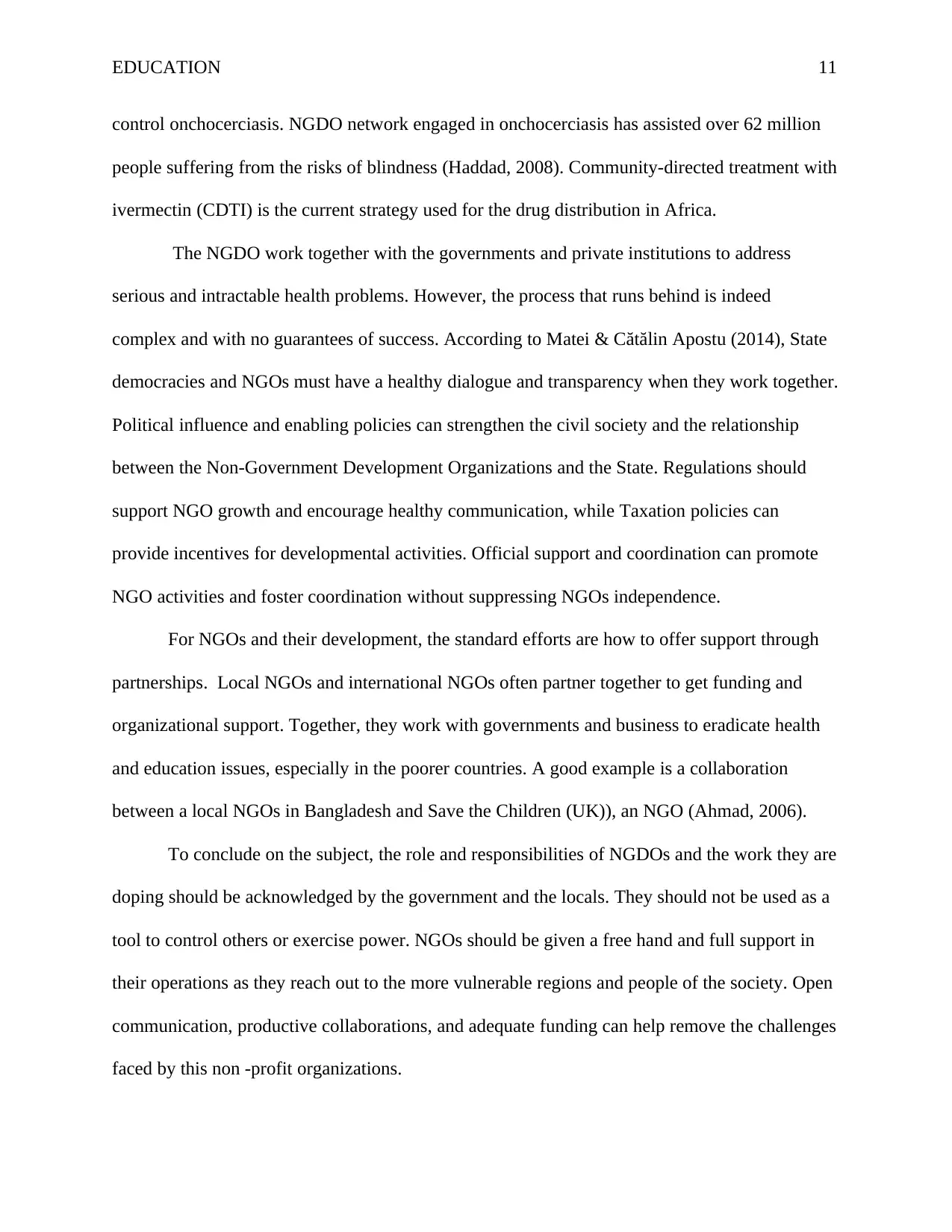
EDUCATION 11
control onchocerciasis. NGDO network engaged in onchocerciasis has assisted over 62 million
people suffering from the risks of blindness (Haddad, 2008). Community-directed treatment with
ivermectin (CDTI) is the current strategy used for the drug distribution in Africa.
The NGDO work together with the governments and private institutions to address
serious and intractable health problems. However, the process that runs behind is indeed
complex and with no guarantees of success. According to Matei & Cătălin Apostu (2014), State
democracies and NGOs must have a healthy dialogue and transparency when they work together.
Political influence and enabling policies can strengthen the civil society and the relationship
between the Non-Government Development Organizations and the State. Regulations should
support NGO growth and encourage healthy communication, while Taxation policies can
provide incentives for developmental activities. Official support and coordination can promote
NGO activities and foster coordination without suppressing NGOs independence.
For NGOs and their development, the standard efforts are how to offer support through
partnerships. Local NGOs and international NGOs often partner together to get funding and
organizational support. Together, they work with governments and business to eradicate health
and education issues, especially in the poorer countries. A good example is a collaboration
between a local NGOs in Bangladesh and Save the Children (UK)), an NGO (Ahmad, 2006).
To conclude on the subject, the role and responsibilities of NGDOs and the work they are
doping should be acknowledged by the government and the locals. They should not be used as a
tool to control others or exercise power. NGOs should be given a free hand and full support in
their operations as they reach out to the more vulnerable regions and people of the society. Open
communication, productive collaborations, and adequate funding can help remove the challenges
faced by this non -profit organizations.
control onchocerciasis. NGDO network engaged in onchocerciasis has assisted over 62 million
people suffering from the risks of blindness (Haddad, 2008). Community-directed treatment with
ivermectin (CDTI) is the current strategy used for the drug distribution in Africa.
The NGDO work together with the governments and private institutions to address
serious and intractable health problems. However, the process that runs behind is indeed
complex and with no guarantees of success. According to Matei & Cătălin Apostu (2014), State
democracies and NGOs must have a healthy dialogue and transparency when they work together.
Political influence and enabling policies can strengthen the civil society and the relationship
between the Non-Government Development Organizations and the State. Regulations should
support NGO growth and encourage healthy communication, while Taxation policies can
provide incentives for developmental activities. Official support and coordination can promote
NGO activities and foster coordination without suppressing NGOs independence.
For NGOs and their development, the standard efforts are how to offer support through
partnerships. Local NGOs and international NGOs often partner together to get funding and
organizational support. Together, they work with governments and business to eradicate health
and education issues, especially in the poorer countries. A good example is a collaboration
between a local NGOs in Bangladesh and Save the Children (UK)), an NGO (Ahmad, 2006).
To conclude on the subject, the role and responsibilities of NGDOs and the work they are
doping should be acknowledged by the government and the locals. They should not be used as a
tool to control others or exercise power. NGOs should be given a free hand and full support in
their operations as they reach out to the more vulnerable regions and people of the society. Open
communication, productive collaborations, and adequate funding can help remove the challenges
faced by this non -profit organizations.
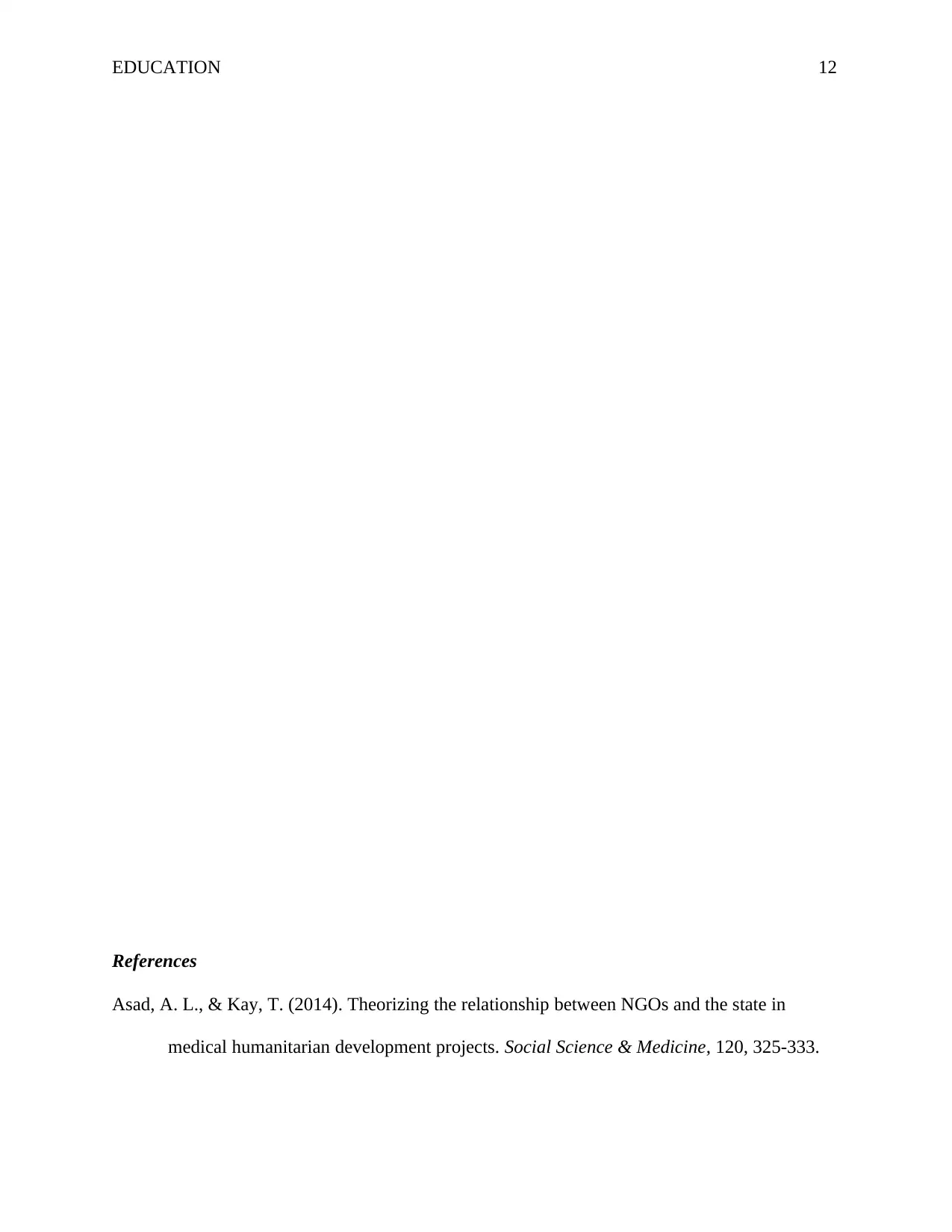
EDUCATION 12
References
Asad, A. L., & Kay, T. (2014). Theorizing the relationship between NGOs and the state in
medical humanitarian development projects. Social Science & Medicine, 120, 325-333.
References
Asad, A. L., & Kay, T. (2014). Theorizing the relationship between NGOs and the state in
medical humanitarian development projects. Social Science & Medicine, 120, 325-333.
⊘ This is a preview!⊘
Do you want full access?
Subscribe today to unlock all pages.

Trusted by 1+ million students worldwide
1 out of 15
Related Documents
Your All-in-One AI-Powered Toolkit for Academic Success.
+13062052269
info@desklib.com
Available 24*7 on WhatsApp / Email
![[object Object]](/_next/static/media/star-bottom.7253800d.svg)
Unlock your academic potential
Copyright © 2020–2025 A2Z Services. All Rights Reserved. Developed and managed by ZUCOL.





